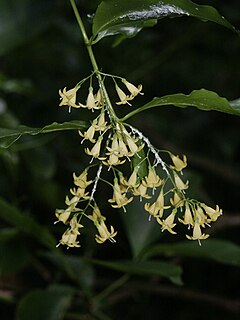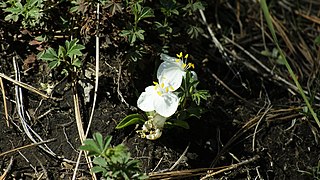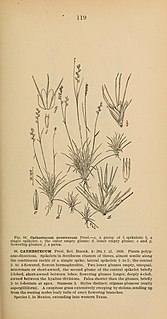
Milla, the Mexican star, is a genus of monocotyledonous plants in the family Asparagaceae, subfamily Brodiaeoideae. They are native mostly to Mexico, with one species extending into Guatemala, Honduras, Arizona, Texas and New Mexico.

Zamia is a genus of cycad of the family Zamiaceae, native to Mexico, the West Indies, and Central and South America as far south as Bolivia. The range of one species (Z. integrifolia, extends into the contiguous United States, i.e. Georgia and Florida.

Tigridia, the peacock flowers, tiger-flowers or shell flowers, is a genus of bulbous or cormous plants, belonging to the family Iridaceae. They have large showy flowers and one species, Tigridia pavonia, is often cultivated for this. The approximately thirty five species in this family grow in the Western Hemisphere, from Mexico to Chile. The tigridia flower is short lived, each often blooming for only one day, but often several flowers will bloom from the same stalk. Usually they are dormant during the winter dry-season. Its roots are edible and were eaten by the Aztecs of Mexico who called it cacomitl and its flower ocēlōxōchitl "Jaguar flower". The genus name means "tiger-like" and alludes to the coloration and spotting of the flowers of the type species Tigridia pavonia.
Bernardia is a plant genus of the family Euphorbiaceae first described for modern science as a genus in 1754. It is native to North and South America, as well as the West Indies.

Garcia is a plant genus of the family Euphorbiaceae and of the monotypic subtribe Garciinae, first described as a genus in 1792. It is native to Central America, Mexico, Colombia, and Venezuela, and also naturalized in some of the West Indies.
- Garcia nutansVahl ex Rohr - Mexico from Sinaloa and San Luis Potosí to Chiapas + Yucatán, Central America, Colombia, Venezuela
- Garcia parvifloraLundell - Chiapas, Tabasco, Veracruz
Acidocroton is a genus of plants under the family Euphorbiaceae first described with this name in 1859. It is native to Colombia and the Greater Antilles.
Dalembertia is a plant genus of the family Euphorbiaceae first described as a genus in 1858. It is native to Mexico and Guatemala.
- Dalembertia hahnianaBaill. - México State, Morelos, Michoacán
- Dalembertia platanoidesBaill. - Oaxaca, Guerrero, México State
- Dalembertia populifoliaBaill. - from Sonora to Oaxaca
- Dalembertia triangularisMüll.Arg. - Guatemala, Chiapas, Oaxaca
Astrocasia is a plant genus of the family Phyllanthaceae first described as a genus in 1905. It is included in the subtribe Astrocasiinae. It is native to Mesoamerica, northern South America, and the western part of the West Indies.
- Astrocasia austinii(Standl.) G.L.Webster - Izabal
- Astrocasia diegoaeJ.Jiménez Ram. & Mart.Gord. - Guerrero
- Astrocasia jacobinensis(Müll.Arg.) G.L.Webster - Bahia, Bolivia
- Astrocasia neurocarpa(Müll.Arg.) I.M.Johnst. ex Standl. - Oaxaca, Querétaro, San Luis Potosí, Tamaulipas
- Astrocasia peltataStandl. - Costa Rica, Nayarit, Jalisco
- Astrocasia tremula (Griseb.) G.L.Webster - Mexico, Central America, West Indies, northern South America
Chamguava is a genus of the botanical family Myrtaceae, first described as a genus in 1991. It is native to southern Mexico and Central America.
- Chamguava gentlei(Lundell) Landrum - Chiapas, Belize, Guatemala, Honduras
- Chamguava musarum(Standl. & Steyerm.) Landrum - Guatemala
- Chamguava schippii(Standl.) Landrum - Guerrero, Chiapas, Belize, Guatemala, Panama

Rojasianthe is a genus of Mesoamerican flowering plants in the sunflower family.

Chiococca is a genus of flowering plants in the family Rubiaceae. It currently holds 23 species that are native to Florida, Texas, Mexico, Central America, much of South America, the West Indies, and the Galápagos.
Billbergia viridiflora is a plant species in the genus Billbergia native to Tabasco, Belize and Guatemala.

Weldenia is a monotypic genus of flowering plant in the family Commelinaceae, first described in 1829. It has one single species: Weldenia candida, which grows originally in Mexico and Guatemala.

Limnobium, common names spongeplant and American frogbit, is a group of aquatic plants in the Hydrocharitaceae described as a genus in 1814. It is widespread in freshwater environments in Latin America, the West Indies, and the United States.

Cathestecum is a genus of the North American plants in the grass family.
Rubus trilobus, the boulder raspberry or delicious raspberry, is Mesoamerican species of flowering plant in the rose family. It is native to Guatemala and to southern and central Mexico.
Rubus pringlei is a Mesoamerican species of brambles in the rose family. It grows in central and southern Mexico and also in Guatemala.
Rubus macrogongylus is a Mesoamerican species of brambles in the rose family. It grows in the State of Chiapas in southern Mexico as well as in the Central American nations of Guatemala and Nicaragua.
Rubus sapidus is a Mesoamerican species of brambles in the rose family. It grows in southern Mexico and Central America.
Quercus candicans is a Mesoamerican species of oak tree in the beech family. It is native to central and southern Mexico and Guatemala. It grows from 1,200 to 2,700 m of altitude in wet montane forests, preferring calcareous soils.








